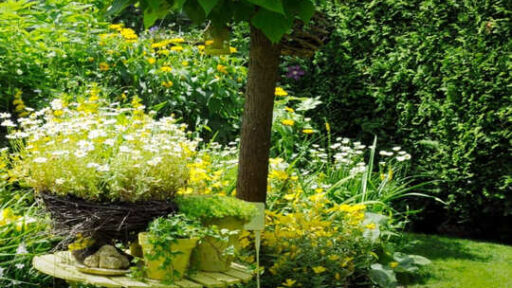If you’ve ever noticed holes mysteriously appearing in your basil leaves, you’re not alone. Those beautiful, aromatic greens can be surprisingly vulnerable to a variety of pests and environmental factors that cause unsightly damage.
- Understanding the Problem
- Common Causes of Holes in Basil Leaves
- Insect Pests That Damage Basil Leaves
- Fungal and Bacterial Infections
- Environmental Factors Contributing to Leaf Damage
- How to Identify the Specific Cause
- Natural Remedies for Pest Control
- Chemical Treatments: When and How to Use Them
- Preventive Measures to Protect Your Basil Plants
- Best Practices for Healthy Basil Growth
- How to Repair and Care for Damaged Leaves
- Companion Planting to Deter Pests
- When to Harvest Basil to Minimize Damage
Understanding the Problem
Basil is a beloved herb known for its fragrant aroma and vibrant green leaves, making it a staple in many kitchens and gardens. However, one common issue that many basil growers encounter is the appearance of holes in the leaves
These unsightly holes not only affect the plant’s aesthetic appeal but can also signal underlying problems that may impact the overall health of your basil.
Common Causes of Holes in Basil Leaves
Holes in basil leaves can be frustrating to spot, especially when you’ve been nurturing your plants with care.
One of the primary culprits is insect pests. Aphids, flea beetles, and caterpillars love to nibble on basil leaves, leaving behind small to large holes. Flea beetles, in particular, are notorious for creating a “shotgun” pattern of tiny holes that can quickly defoliate your plant.
Similarly, slugs and snails often feast on basil during the night, leaving irregularly shaped holes and slimy trails as telltale signs.
Besides pests, environmental factors can also contribute to holes in basil leaves. Heavy rain or strong winds may cause physical damage, tearing delicate leaves.
Additionally, nutrient deficiencies or fungal infections can weaken the leaf tissue, making it more susceptible to damage and holes.
Insect Pests That Damage Basil Leaves
One of the most common reasons basil leaves develop holes is due to insect pests. These tiny invaders can quickly turn a healthy basil plant into a tattered mess if left unchecked.
Common culprits include flea beetles, caterpillars, and slugs—all of which love to feast on the soft, tender leaves of basil.
Flea beetles are small, shiny black or brown bugs that jump like fleas when disturbed. They chew small, round holes in the leaves, often leaving a “shotgun” pattern of damage.
Caterpillars, including the larvae of moths and butterflies, can cause larger, irregular holes by munching through entire sections of leaves. Slugs and snails are nocturnal feeders, leaving ragged holes and often slime trails on the foliage.
To tackle these pests, start by regularly inspecting your plants, especially the undersides of leaves where eggs and larvae often hide. Handpicking caterpillars and slugs during early morning or evening hours can be surprisingly effective.
Using natural deterrents like neem oil or insecticidal soap helps control many insect pests without harming your basil or the environment. Additionally, encouraging beneficial insects like ladybugs and lacewings can keep pest populations in check naturally.
Fungal and Bacterial Infections
Fungal and bacterial infections are common culprits behind holes developing in basil leaves.
When basil leaves become infected, you might notice small, irregularly shaped holes or spots that gradually expand as the infection progresses. Common fungal diseases affecting basil include downy mildew and leaf spot, while bacterial infections such as bacterial leaf spot can also cause visible damage.
Infected leaves often show discoloration around the holes, turning yellow, brown, or black, which indicates tissue decay. If left untreated, these infections can spread rapidly, weakening the plant and reducing its overall yield.
To combat fungal and bacterial infections, it’s important to maintain good garden hygiene. Remove and dispose of affected leaves promptly to prevent the spread of spores or bacteria.
Ensure proper spacing between plants to improve air circulation and reduce moisture buildup. Water your basil at the base rather than from above to keep the foliage dry.
Additionally, using organic fungicides or bactericides can help control the infection without harming your plant or the environment.
Environmental Factors Contributing to Leaf Damage
Basil leaves developing holes can often be traced back to various environmental factors that stress the plant or create favorable conditions for pests and diseases.
One common culprit is extreme weather conditions—excessive heat, strong winds, or heavy rain can physically damage the delicate leaves, causing tears or holes.
Additionally, inconsistent watering practices, such as letting the soil dry out completely and then overwatering, can weaken the plant and make it more susceptible to damage.
Another environmental factor to consider is sun exposure. While basil thrives in full sun, intense, direct sunlight during the hottest parts of the day can sometimes lead to leaf scorch, where the edges of leaves dry out, become brittle, and develop holes.
Similarly, poor air circulation around the plant, often caused by overcrowding or planting in a shady, humid spot, can create a damp environment that encourages fungal infections, which also result in leaf damage.
To minimize environmental damage, try to provide your basil with consistent watering, shelter from harsh winds, and adequate spacing to promote airflow. Using mulch can help retain soil moisture and regulate temperature, creating a more stable environment for healthy leaf growth.
How to Identify the Specific Cause
Identifying the specific cause behind holes in your basil leaves is the crucial first step toward effective treatment and prevention.
Start by closely examining your plant for visible signs of pests or damage.
- Look for tiny insects such as aphids, caterpillars, or flea beetles on the undersides of leaves and along the stems.
- Next, consider environmental factors
- Excessive sun exposure can cause leaf scorching, which sometimes appears as holes or dry patches
- Overwatering or poor drainage may lead to root rot and weaken the plant, making leaves more susceptible to damage.
- Check for any signs of nutrient deficiency as well
- If you’re unsure, try isolating the plant from others to see if the problem persists or spreads.
Taking clear photos and consulting local gardening centers or online plant forums with your observations can also help pinpoint the issue
Natural Remedies for Pest Control
One of the most effective solutions is introducing beneficial insects like ladybugs or lacewings into your garden.
Another simple and eco-friendly method is to use homemade sprays made from ingredients like neem oil, garlic, or mild soapy water. Neem oil, extracted from the neem tree, works as a natural insect repellent and disrupts the life cycle of many pests.
To prepare a garlic spray, blend a few cloves with water, strain the mixture, and spray it directly onto the affected leaves.
Mild soapy water can also suffocate soft-bodied insects when applied carefully.
Chemical Treatments: When and How to Use Them
Chemical treatments can be an effective option to protect your basil plants when other methods have not sufficiently controlled the issue of holes in the leaves. However, it’s important to approach chemical use with caution to ensure the health of your plants, the environment, and ultimately your own safety.
Before turning to chemicals, identify the specific pest or disease causing the damage. Common culprits include aphids, flea beetles, or fungal infections, each of which may require different treatment approaches. Use targeted insecticides or fungicides that are labeled safe for use on basil and follow the product instructions carefully.
Apply chemical treatments only when necessary—typically if you have a severe infestation or persistent leaf damage that other organic or cultural controls haven’t resolved.
Overuse or misuse of chemicals can harm beneficial insects like pollinators and lead to resistant pest populations.
Always wear protective gear when applying chemicals, and avoid spraying during the hottest parts of the day to minimize leaf burn. After treatment, monitor your plants closely for improvements or any adverse effects.
Preventive Measures to Protect Your Basil Plants
Preventing damage to your basil plants is key to maintaining their health and ensuring a bountiful harvest. Here are several effective preventive measures to keep your basil leaves free from holes and other common issues:
1. Regular Inspection:
Make it a habit to check your basil plants frequently for signs of pests such as aphids, caterpillars, or beetles. Early detection allows you to take swift action before the damage becomes extensive.
2. Proper Spacing and Airflow:
Plant your basil with enough space between each plant to encourage good air circulation. This reduces the risk of fungal infections and discourages pests that thrive in damp, crowded conditions.
3. Use Organic Pest Control:
Introduce natural predators like ladybugs or use neem oil sprays to keep pest populations under control without harming your plants or the environment.
4. Keep the Area Clean:
Remove fallen leaves and debris around your basil plants, as these can harbor pests and diseases that contribute to leaf damage.
5. Watering Habits:
Water your basil at the base rather than from overhead to minimize moisture on the leaves, which can attract fungal diseases and weaken the plant’s defenses.
Best Practices for Healthy Basil Growth
First, plant your basil in well-draining soil that is rich in organic matter. Basil prefers a sunny spot with at least 6 hours of direct sunlight daily, which promotes strong, vigorous growth and helps prevent fungal diseases that can damage leaves.
Water your plants consistently:
- the soil moist but not waterlogged
- overwatering can lead to root rot and weaken the plant’s natural defenses.
Regularly inspect your basil for pests such as aphids, caterpillars, or flea beetles, which are common culprits behind holes in leaves.
Use natural pest control methods:
- neem oil sprays
- introduce beneficial insects such as ladybugs
Additionally, practice good air circulation by spacing plants adequately and pruning frequently; this reduces humidity around the foliage and makes it harder for fungal infections to take hold.
Finally, harvest basil leaves regularly by pinching off the tops of the stems.
- This encourages bushier growth
- prevents the plant from flowering too early
Flowering too early can cause leaves to become bitter and more susceptible to damage.
How to Repair and Care for Damaged Leaves
When basil leaves develop holes, it’s important not only to address the cause but also to care for and repair the damaged foliage to keep your plant healthy and thriving. While you can’t fully “repair” holes in leaves, there are several steps you can take to support the plant’s recovery and prevent further damage.
First, gently prune away severely damaged leaves. Removing leaves that are extensively chewed, or yellowing helps the plant focus its energy on producing new, healthy growth. Use clean, sharp scissors or pruning shears to make clean cuts and avoid causing additional stress.
Next, maintain optimal growing conditions to encourage rapid healing and new leaf developmen.
Ensure your basil is getting sufficient sunlight—ideally 6 to 8 hours of indirect sunlight daily—and consistent watering that keeps the soil moist but not waterlogged. Proper air circulation also helps reduce the risk of fungal infections that can worsen leaf damage.
Applying a balanced, water-soluble fertilizer every few weeks can give your basil the nutrients it needs to recover more quickly.
Additionally, consider using organic foliar sprays, such as neem oil or insecticidal soap, to deter pests that may cause holes without harming the plant.
Finally, monitor your basil regularly for signs of new damage. Early detection allows you to take prompt action, whether that means adjusting care routines or addressing pest infestations before they spread.
Companion Planting to Deter Pests
Companion planting is a natural and effective way to protect your basil plants from pests that cause those frustrating holes in the leaves.
For example, planting marigolds alongside your basil is a popular choice, as marigolds emit a strong scent that deters aphids, whiteflies, and other common basil pests.
Similarly, growing garlic or chives near your basil can help ward off spider mites and beetles due to their pungent aroma.
Beyond repelling pests, companion plants can also improve the overall health of your basil by enhancing soil nutrients and providing shade or wind protection. This holistic approach reduces the need for chemical pesticides, making your garden safer and more eco-friendly.
When planning your garden layout, consider mixing in these natural allies to create a thriving, pest-resistant basil patch that keeps your leaves hole-free and your plants flourishing all season long.
When to Harvest Basil to Minimize Damage
Basil leaves tend to develop holes when the plant is stressed, weakened, or infested by pests — and improper harvesting can exacerbate these issues. To avoid this, it’s best to harvest basil regularly but carefully, starting when the plant has at least six to eight sets of leaves.
When picking, always use clean, sharp scissors or pinch off leaves just above a leaf node (where leaves emerge from the stem).
This encourages new growth and helps the plant stay strong and resilient against pests and diseases that cause holes. Avoid stripping too many leaves at once; harvesting no more than one-third of the plant at a time prevents unnecessary stress.
Additionally, harvesting basil in the morning after the dew has dried but before the heat of the day sets in helps preserve the leaves’ flavor and texture.



